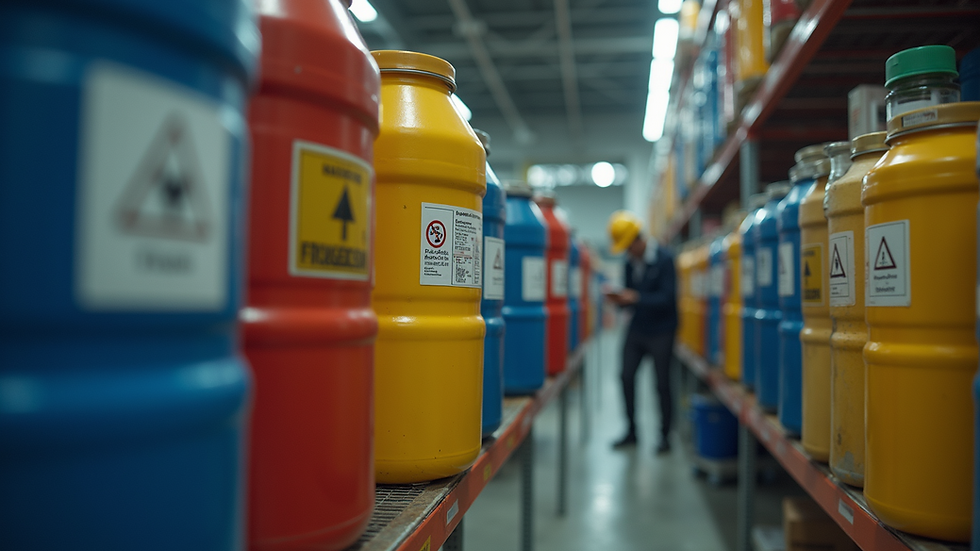Essential Safety Protocols for Hazardous Materials
- Elite Accreditation Consultants
- Aug 11
- 3 min read
Handling hazardous materials requires strict adherence to safety protocols to protect workers, the environment, and the public. These materials can pose serious risks such as chemical burns, explosions, toxic exposure, and environmental contamination. Therefore, comprehensive training and clear safety procedures are essential for anyone involved in the transportation, storage, or handling of hazardous substances.
Importance of Hazmat Training for Safety and Compliance
Hazmat training is designed to educate employees on the proper handling, packaging, and transportation of hazardous materials. This training helps prevent accidents and ensures compliance with federal and state regulations. For example, workers learn how to identify hazardous materials using labels and placards, understand the risks associated with each type, and apply emergency response techniques.
Proper training also reduces liability for companies by minimizing the risk of fines and legal action due to non-compliance. It promotes a culture of safety where employees are aware of potential hazards and know how to respond effectively.
Key components of effective hazmat training include:
Understanding hazard classes and labels
Safe packaging and container requirements
Proper documentation and shipping papers
Emergency response and spill containment
Personal protective equipment (PPE) usage

How Hazmat Training Enhances Workplace Safety
Hazmat training equips employees with the knowledge to recognize hazardous materials and understand the risks involved. This awareness is critical in preventing accidents such as chemical spills, fires, or exposure to toxic substances. For instance, workers learn how to handle corrosive chemicals safely by using appropriate PPE like gloves and goggles.
Training also covers the correct procedures for loading and unloading hazardous materials to avoid spills or damage. Employees are taught to follow strict protocols for storage, ensuring incompatible materials are separated to prevent dangerous reactions.
In addition, hazmat training includes emergency preparedness drills. These drills simulate real-life scenarios such as chemical leaks or fires, allowing workers to practice evacuation routes, containment methods, and communication protocols.
Practical recommendations for workplace safety:
Conduct regular refresher training sessions.
Maintain clear signage and labeling in storage areas.
Provide accessible spill kits and emergency equipment.
Encourage reporting of unsafe conditions immediately.

What is required for US Dot hazardous materials training?
The US Department of Transportation (DOT) mandates specific training requirements for employees involved in the transportation of hazardous materials. This training ensures that all personnel understand the regulations and can safely manage hazardous shipments.
DOT hazmat training requirements include:
Initial training before handling hazardous materials
Annual refresher training to maintain knowledge
Training on hazard communication, packaging, and labeling
Emergency response information and procedures
Security awareness to prevent unauthorized access or tampering
Employers must document all training activities and maintain records for at least three years. Training must be tailored to the employee’s job functions and updated whenever regulations change or new hazards are introduced.
For those seeking comprehensive certification, dot hazmat training programs provide detailed instruction aligned with DOT standards.

Best Practices for Handling and Storing Hazardous Materials
Safe handling and storage of hazardous materials are critical to preventing accidents and environmental damage. Follow these best practices to maintain a safe workplace:
Labeling and Identification: Always label containers clearly with the correct hazard class and handling instructions.
Segregation: Store incompatible materials separately to avoid dangerous chemical reactions.
Ventilation: Ensure storage areas are well-ventilated to prevent the buildup of toxic fumes.
Spill Containment: Use secondary containment systems like trays or berms to catch leaks or spills.
PPE Usage: Require appropriate personal protective equipment based on the material’s hazard level.
Regular Inspections: Conduct routine checks for leaks, corrosion, or damaged containers.
Emergency Equipment: Keep fire extinguishers, spill kits, and eyewash stations readily accessible.
Implementing these practices reduces the risk of incidents and ensures quick response if an emergency occurs.
Emergency Response and Incident Management
Despite best efforts, accidents can happen. Having a clear emergency response plan is essential to minimize harm and control the situation effectively.
Key elements of an emergency response plan include:
Immediate Notification: Alert supervisors and emergency services as soon as an incident occurs.
Evacuation Procedures: Define clear evacuation routes and assembly points.
Containment Measures: Use spill kits and absorbents to contain leaks quickly.
Medical Assistance: Provide first aid and seek medical help for exposed individuals.
Incident Reporting: Document the event thoroughly for regulatory compliance and future prevention.
Training employees on these procedures ensures they can act confidently and efficiently during emergencies.
By following these essential safety protocols and investing in quality hazmat training, organizations can protect their workforce, comply with regulations, and maintain a safe environment when working with hazardous materials.




Comments